Track
Day; A Cruiser's-Eye View
Let me tell you right up front: I ride a cruiser. Don't get
me wrong, I can appreciate the look and "flash" of
a nice sportbike, but speed has never been my thing. I'd rather
cruise down a country lane than tear up the twisties. But when
Ken suggested it might be fun to check out a "track day"
nearby, I thought it might be interesting to see how the other
half lives. So, not long after sunrise on Sunday, August 1,
after a rather-too-late Saturday night, we got up, geared up,
and rode eighty-five miles to the Blackhawk Farms Raceway in
Rockton, Illinois.
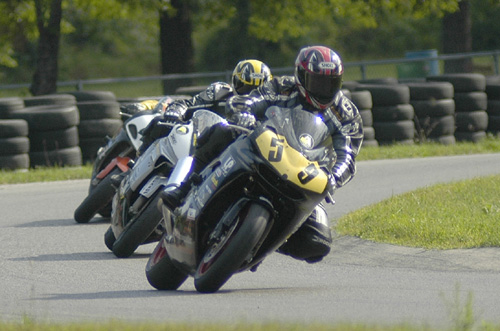
Advanced Group, Turn
4
We pulled into the lot a little before 8:00 am. We got a few
odd looks from the other riders; my Honda VLX and Ken's Honda
Shadow Spirit were definitely out of place in a sea of sportbikes
and the occasional sport-tourer. (We did find out, later, that
there was one lonely Goldwing parked in the opposite end of
the parking lot.) The reaction we got was bemused, but by no
means hostile; it can best be summed up by the remark that one
rider made to Ken, "I bet those pipes'll drag in the corn
ers..."
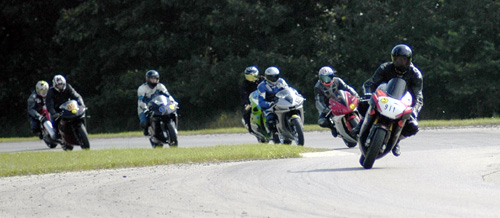
Intermediate Group,
Turn 3
I hurried to make the 8:15 Rider's Meeting; mandatory for all
riders. They asked me for my registration number; I explained
that I wasn't a journalist but that I'd stayed at a Holiday
Inn Express last nigh t... After they stopped laughing, they
told me that I was welcome to sit in.
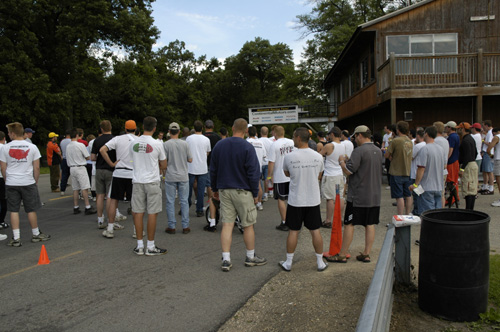
Rider's Meeting
The Rider's Meeting was conducted by Garth Cloyd, the Midwest
Regional Director for NESBA (North East Sport Bike Association;
I later learned they started in New England, and when they went
national the name already had enough recognition they were stuck
with it). He gave a quick rundown of the hand signals, the flags
used, and the general track rules (later summed up succinctly
in a comment I overheard one rider give another: "No wheelies,
stoppies, or burnouts; save those for the street!"). This
took about five minutes, then the "Beginner" group
trooped off to a classroom for a more in depth orientation,
while the "Advanced" group geared up and headed for
the track.
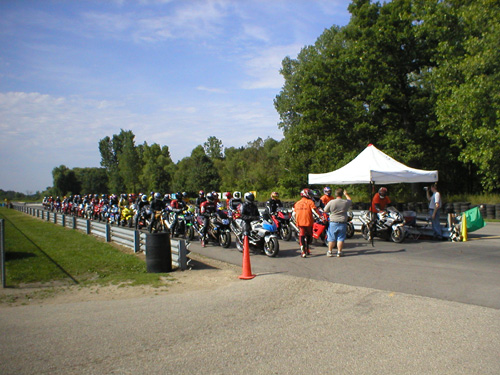
At the starting line
I tagged along with the Beginners; there were thirty-five of
us in all. Our instructor was John Mahlendorf, who told us he
wasn't usually the guy who did the orientation. However, since
he'd gone down yesterday in a curve and his arm was in a sling,
he wasn't going to be doing any track time so he figured he'd
fill in and make himself useful. The class ran about a half
an hour, and explained the track procedures in considerably
more detail. I learned that riders are divided into three groups;
Beginners, Intermediate, and Advanced. It takes certification
by a Control Rider (a sort of umpire that rides with the groups)
to advance to the next level, and from what I picked up later,
it seems it takes a few years in one category on average to
advance to the next. Beginners are not allowed to pass at all
except with the direct permission of a Control Rider; John was
very emphatic that this was NOT a race; check the egos at the
door. Intermediate Riders are allowed to pass on the straightaway
only. Advanced Riders are allowed to pass at any time. However,
NOBODY is allowed to ride in a manner the Control Riders deem
"unsafe". Each group gets twenty minutes on the track
at a time, and there are six sessions for each group during
the day. Every corner has a flag station, and their job is principally
to warn riders of hazards on the track around blind corners
(yellow flag for debris; red flag to return immediately to the
pits), and also to tell the riders (with a white flag for one-lap-left
and a checkered flag for last lap) that the twenty-minute session
is over. They will also tell a rider, with a black flag, that
something is wrong with his bike and he specifically should
return to the pits.
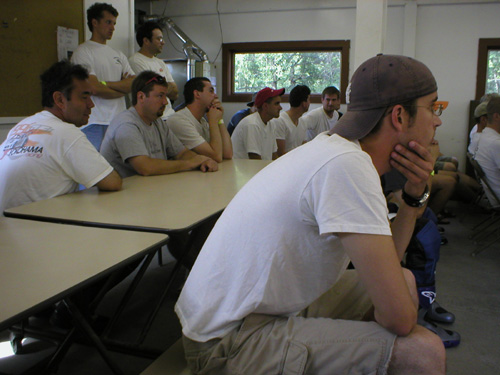
Beginner's Class
Control Riders are on track at a ratio of about one Control
Rider for every four or five regular riders. They wear orange
t-shirts with a big FOLLOW ME printed on the back. They have
hand signals to tell a rider to follow their line, to follow
them directly, to tell them they have permission to pass, or
do NOT have permission to pass, to tell a rider to slow down,
and to tell a rider to follow them into the pit for a "discussion".
It was strongly implied that the most common reason for that
last instruction was to discipline squids....
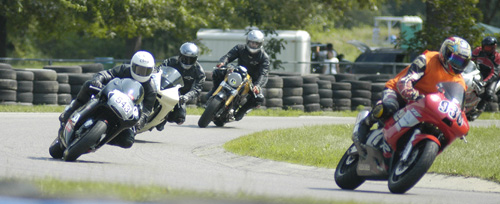
Control Rider Leading
Beginner Group
John
also had detailed, and sobering, instructions as to what to
do in the event of a crash. Better to TRY to hold the bike on
the track than to run off and insure a crash. If you lay the
bike down, go limp and don't move. Stay down for a bit; raise
a hand to tell the safety guy in the flag station that you're
ok, IF you're ok. Don't try to stand up until you've patted
the ground to be sure you've stopped sliding; he's seen lots
of guys try to stand up while still sliding at forty miles an
hour. If you go down on the track, stay exactly where you are;
if you try to run off the track, people will run you over, but
if you stay put they can avoid you. And don't target fixate
on a down rider! He told the group just to stay where you are
until help gets there; he mentioned that he went down in such
high weeds, with the bike pinning him so he couldn't get up,
that they had to use machetes to cut down the weeds to find
him.
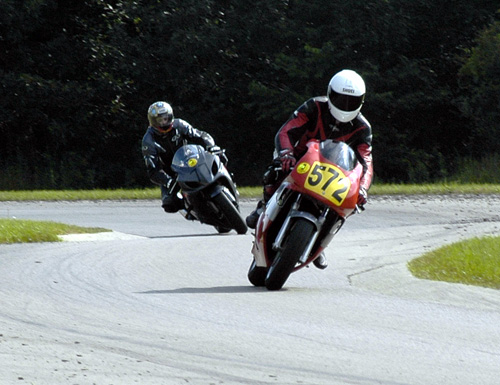
Intermediate Group
Riders
He
went on to more pleasant topics, giving an overview of counter
steering, how to determine your best line on the track, and
the importance of smooth input into throttle and brake. He said
something that surprised me; he told the riders not to use the
rear brake at all. He said that was fine for the Advanced group,
who wanted to slew around corners, but the Beginners shouldn't
even try it. Save the rear brake for if you're running off the
track and want to keep your bike up. Beginners will have too
much else to keep track of to deal with; keeping it to the front
brake only keeps it simpler.
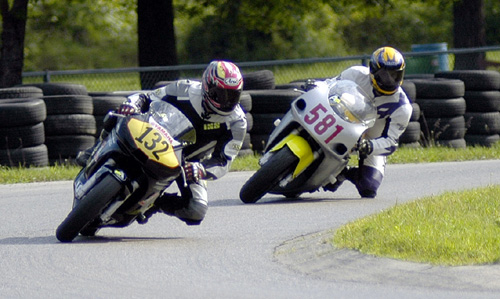
Advanced Group Riders,
Turn 4
After
the orientation, John very kindly offered to show me around
a little. He gave me the obligatory plugs for the sponsors;
a motorcycle tire company, a photographer, a video service that
actually follows a specific biker around for a twenty-minute
session and tapes his/her performance, and a sunshade that velcro's
to the visor of the helmet. He told me he was an Advanced class
rider, and had been doing track days for about five years. He
mentioned, when I asked about the sling, that he thought he'd
just sprained his shoulder, but was going to a doctor that evening
to find out for sure. Now there's a true addict; he wouldn't
give up a track day that he couldn't even ride in, in order
to get an X-ray!
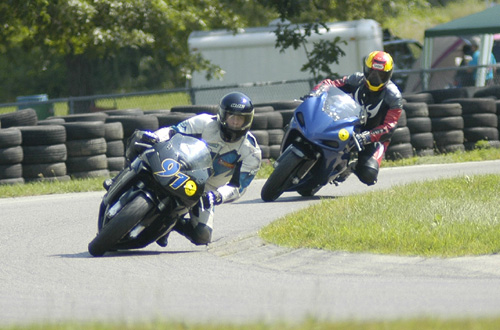
Intermediate Group
Riders, Turn 4
John introduced me to Matt Drucker, the "General Technical
Guru." Matt is the track's recognized expert on suspension,
tire mounting, and general mechanics. Matt is the guy who inspects
the bikes before they're allowed in the track; he showed me
how a bike is prepped for a race.
First,
all the glass is taped. ALL of it. Headlights, taillights, turn
signals (if they're on the bike at all), and mirrors (which
must be removed entirely except for the Beginner class).
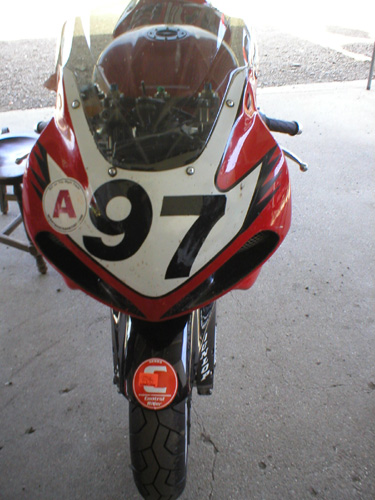
Taped lights and Advanced
& Control Rider stickers
All
bikes must display a number (you sign up for it beforehand)
on either the front, the tail, or both.
All bikes also must have a "B", "I", "A",
or "C" sticker prominently displayed to show which
class the rider is in; Beginner, Intermediate, Advanced, or
Control.
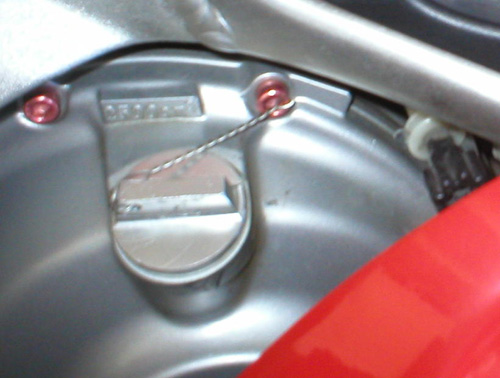
Oil Fill Cap with
Safety Wire
Advanced
class bikes must have the oil fill and drain plugs wired shut,
and the oil filter wired in place.
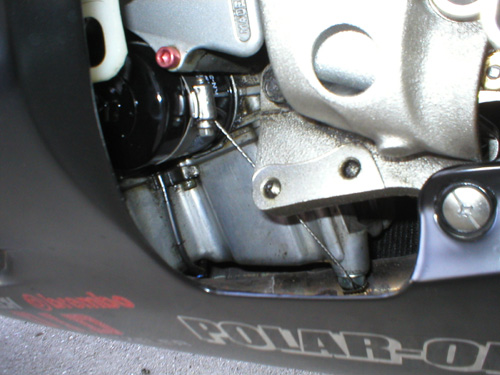
Oil Drain Plug &
Filter with Safety Wire
Except
for Beginners, antifreeze must be drained and replaced with
water; apparently antifreeze is very slippery and difficult
to clean off the track.
Matt
also strongly suggested replacing the stock plastic with a cheap
aftermarket faring before racing; much less expensive to repair
or replace after a spill.
After
this edifying conversation, I spent some time talking to his
wife, Carol Drucker, whom John told me is universally known
as "Race Mom." She's earned this title, because she's
known as the best Control Rider at bringing along the Beginner
class and teaching them the ropes. When I asked her about that,
she laughed and told me that she's a school teacher, so she
has more patience with beginners. She told me she often has
to explain very elementary principles such as counter steering.
She'll start a class in first gear for the first session, demonstrating
the lines that they'll need to use at higher speeds. Then she'll
gradually work up through the gears over the course of the day.
She told me me, "You can't go fast until you learn to ride
it slow." Often, many of her class start the day by coasting
through or even braking in turns; she has to teach them to accelerate
smoothing through the curves. And Carol emphasized how important
smoothness is; at high speeds, a jerky input means the chain
will jolt forward and the tire might break loose. She repeated
the old adage, "Anybody can ride fast on the straightaway;
it takes skill to ride fast on the turns."
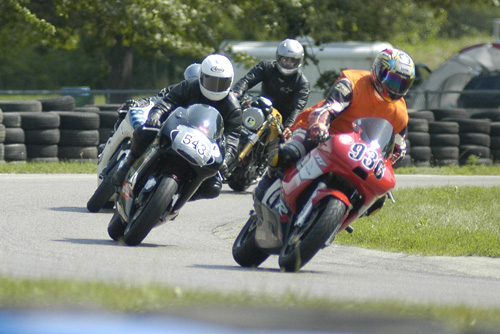
Carol Drucker leading
Beginner Group
Carol
told me she's seen all sorts of bikes on the track over the
years, from 250s on up, although she recommended at least a
400 for a track bike. When I laughingly suggested my VLX, she
told me that she'd seen Harleys on the track. "Of course,
they kinda cruised through the turn s..."
Then
she had to suit up to take her first class of Beginners through
their paces, so I went off to see what else I could see.
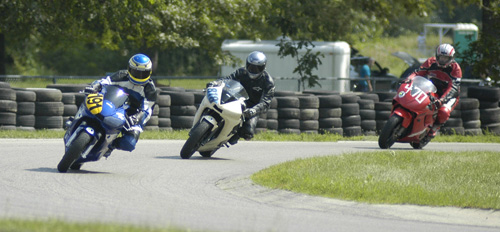
Beginner Group, Turn
4
I wandered over to the edge of the infield, and watched the
riders tear up the track. As I walked toward a corner, I saw
some movement in the grass off the track, and then a rider standing
up. Some other bystanders told me that I'd JUST missed seeing
him highside. The other spectators told me he'd come off the
track, fishtailed, highsided, and then the bike cart wheeled
four or five times. Fortunately, he seemed fine, if understandably
angry with himself. When that session of was over and the Safety
Officer (flag man) indicated it was safe, he pushed the bike
back across the track to the infield and his trailer; he was
done for the day. I asked around; while crashes weren't unknown,
they rarely resulted in injury. Various people gave me various
estimates of the average number of crashes per day, but the
most common number I heard was about five or ten a day, with
only a couple a day as day-ending. And short days are usually
because the bike is busted up, not because the rider is; John
Mahlendorf's mishap was the exception rather than the rule.
Good gear is invaluable, and every rider there will tell you
that.
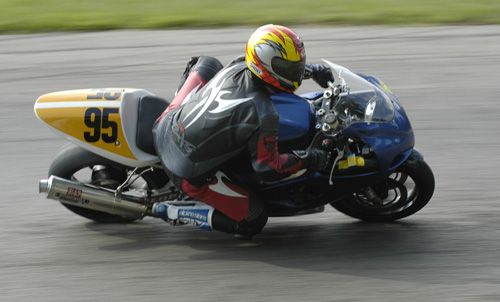
Intermediate Rider,
Turn 3
I
noticed there were very few women at the event. There was one
female rider in the Beginner class, and one in the Intermediate
class. And other than a couple of Control Riders (like Carol
Drucker), and a scattering of wives and girlfriends, that was
it. The crowd was at least 90% male; apparently most wives/girlfriends
don't care to spend all day of a 90ºF. day in the infield
of a noisy racetrack. Or possibly the racers spend so much time
at the track that they don't have wives or girl friends... I
talked to one of the women, Molly Maiers. She told me she doesn't
ride, except on the back of her boyfriend's bike, but he's obsessed
with track days and racing, and she's gotten to be pretty good
at being amateur pit crew; especially with tire changing. She
also told me the purpose of what I'd mentally labeled"tire
cozies;" they're actually tire warmers, that plug into
an outlet and prevent the tires from cooling off and losing
their stickiness between track sessions.
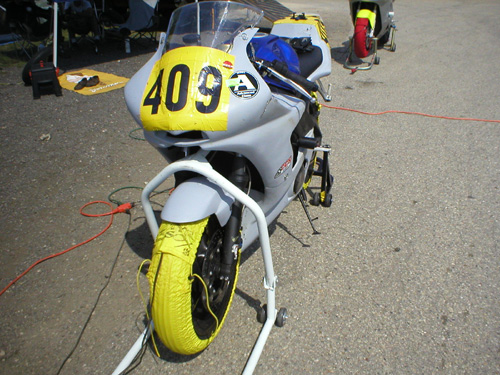
Tire warmers
I
spent quite a lot of time talking to one of the Advanced Class
riders, Eric Blood, who rides a Yamaha 03R6. He told me he's
been doing track days since 1989, and rides motorcross, super-moto,
and even does ice racing as well. He explained that there are
relatively few crashes at a track day, because there's no pressure;
"you're not racing and so your ego isn't on the line."
He told me that track days are highly addictive, and hard on
a marriage. Eric buys tires cash-on-the-barrel, so his wife
won't see the credit card bill and go through the roof. When
I enquired, he told me he goes through a $350 set of tires every
track day; each set is good for only about six twenty-minute
sessions and then they're shot. On race days, he goes through
two sets of tires in one day. "It's a really expensive
hobby," Eric told me with a rueful smile. While I was talking
with him, he was changing his tires. They were practically v-shaped
in profile; the sidewalls were abraded away to nothing, while
there was still tread on the centers. Sort of reverse "chicken
stripes". When I asked, Eric told me that some people sell
their used track tires for street tires, since the center is
still good and that's what most people use most of the time
on the street, although racing slicks are not really designed
for street use. Still, the tires rarely get hot enough on the
street to cause a problem, and the poseurs like them because
they can pretend they're the ones that wore the sidewall off
the tires! Eric emphasized to me that stunting is severely frowned
on. "Wheelies, stoppies, and burnouts -- save 'em for the
street. They have no place on the track."
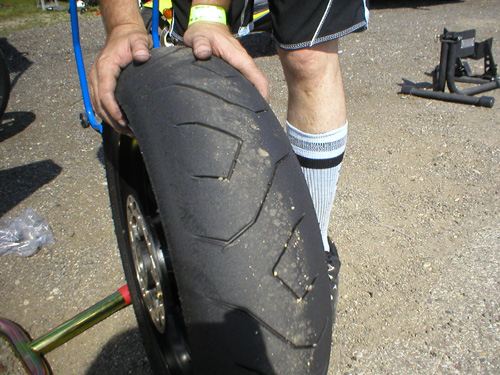
"Anti-Chicken
Stripes"
The
friendliness and comaraderie of the folks at the track day was
remarkable; when the Advanced Group was called and Eric had
to go line up for his turn on the track, he offered me the keys
to his Aprilia scooter so I could ride around and check out
the rest of the place in comfort. (Many folks brought scooters,
pocket bikes, or little dirt bikes for infield transportation.)
I was sorely tempted, but I just couldn't accept the responsibility;
there was a lot of dirt and gravel in the infield and Id've
hated to drop his shiny scoot. Still, I threw my leg over it
(and I do mean OVER it; I forgot it was a scooter and didn't
use the pass-through!) and he convinced me to ride it a few
feet. Automatic transmissions are funky; I wanted to clutch
with the rear brake. He insisted I keep the scoot while he was
on the track, but I declined, and gave him back the keys with
my profuse thanks. We'd known each other for a grand total of
half an hour, and he was willing, even eager, to let me ride
his new Aprilia, when he wouldn't even be around to supervise!
I'm still amazed at that level of trust for a complete stranger.
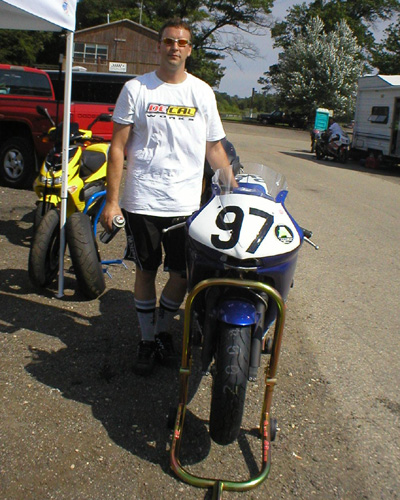
Eric Blood
It
was a good day. Do I want to get out there and burn up the track?
Well, I admit even a die-hard cruiser like me started to get
a little tempted!
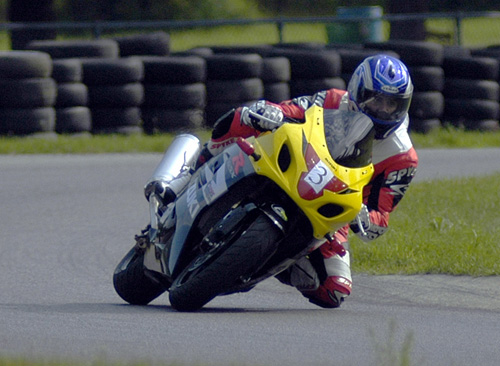
... Someday,
maybe ...
Cassy
Beach is an associate editor for Beginner Bikes Magazine, and
also moderates our New Rider Forum: Women Only section.

